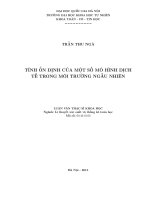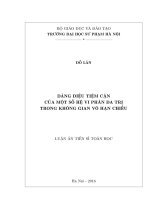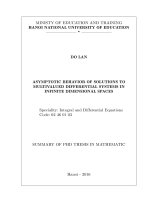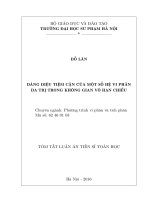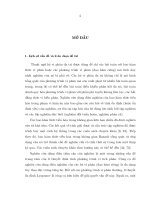Dáng điệu tiệm cận của một số mô hình quần thể trong hệ sinh thái với môi trường ngẫu nhiên
Bạn đang xem bản rút gọn của tài liệu. Xem và tải ngay bản đầy đủ của tài liệu tại đây (1.1 MB, 159 trang )
VIETNAM NATIONAL UNIVERSITY, HANOI
VNU UNIVERSITY OF SCIENCE
Tran Dinh Tuong
ASYMPTOTIC BEHAVIOR OF
POPULATION MODELS IN ECOSYSTEM
WITH RANDOM ENVIRONMENT
THESIS FOR THE DEGREE OF
DOCTOR OF PHILOSOPHY IN MATHEMATICS
HANOI
2020
VIETNAM NATIONAL UNIVERSITY, HANOI
VNU UNIVERSITY OF SCIENCE
Tran Dinh Tuong
ASYMPTOTIC BEHAVIOR OF
POPULATION MODELS IN ECOSYSTEM
WITH RANDOM ENVIRONMENT
Speciality: Differential and Integral Equations
Speciality Code: 9460101.03
THESIS FOR THE DEGREE OF
DOCTOR OF PHYLOSOPHY IN MATHEMATICS
Supervisors: PROF. DR. NGUYEN HUU DU
ASSOC. PROF. DR. NGUYEN THANH DIEU
HANOI
2020
I HC QUăC GIA H
TRìNG
I HC KHOA HC Tĩ NHI N
Trn
D NG
NáI
nh Tữợng
I UTI MC NCếAMáTSă
M H NH QU N TH
TRONG H
SINH TH I
VI MI TRìNG NG U NHI N
Chuyản ng nh: Phữỡng trnh Vi phƠn v Tch phƠn
MÂ s: 9460101.03
LU N
NTI NS TO NHC
Ngữới hữợng dÔn khoa hồc:
GS. TS. NGUY N HU Dì
PGS. TS. NGUY N THANH DI U
H NáI
2020
Contents
Abstract
Tâm t›t
List of Figures
List of Tables
List of Notations
Introduction
Chapter 1
1.1
Stochastic processes . . . . . . . . . . .
1.1.1.
1.1.2.
1.1.3. LÈvy process . . . . . . . . . . . .
Stochastic dierential equations (SDE
1.2
1.2.1. SDEs with Markovian Switch
1.2.2.
1.3
Preliminaries for stochastic mathema
Chapter 2 Long-term behavior of stochastic predator-prey systems
2.1
Dynamic behavior of a stochastic pre
switching . . . . . . . . . . . . . . . . . . . .
i
2.1.1. Introduction . . . . . . . . . . . . .
2.1.2.
2.1.3.
2.2
On the asymptotic behavior of a stoc
Ivlev's functional response and jump
2.2.1. Introduction . . . . . . . . . . . . .
2.2.2. Introductory results . . . . . . .
2.2.3. Almost necessary and sucien
2.2.4. Discussion and numerical ex
Chapter 3 Extinction and permanence in a stochastic SIRS model
in regime switching with general incidence rate
3.1
Introduction . . . . . . . . . . . . . . . . . . .
3.2
Sucient and almost necessary cond
3.3
Discussion and numerical experime
Conclusion
The author's publications related to the thesis
Appendices
Bibliography
Acknowledgments
The completion of this thesis could not have been possible without the guidance,
assistance, and participation of so many people whose names may not all be enumerated. Their contributions are greatly appreciated and gratefully acknowledged.
First and foremost, no words can express fully my gratitude and appreciation to my
primary supervisor, Professor Nguyen Huu Du for his tireless support and endless
guidance, and infusing spirit into my research.
I also wish to express the deepest thanks to the thesis co-supervisor, Associate
Pro-fessor Nguyen Thanh Dieu for his kind comments, valued suggestions, and
sharing great ideas during this course.
I am particularly grateful to Dr. Nguyen Hai Dang for many valuable discussions
and his great support during my work. I own my thanks to Dr. Tran Quan Ky for
his contribution to our joint work [Pub. 2].
I would like to thank all the teachers, staff members and the management of the
Faculty of Mathematics Mechanics and Information Technology at VNU University
of Science, Vietnam National University, Hanoi as well as VIASM for their great
support, lessons as well as opportunities for completion of the research.
I wish to thank my friends, who always trust, encourage and support me over the
years. Lastly, I would like to share this moment with my family. I am indebted to my
parents, my wife, Cherry, for their endless care, love and patience.
Hanoi, February 2020
PhD candidate
Tran Dinh Tuong.
iii
Abstract
Abstract. In this thesis, we consider long-term behavior of a class of formulated
population models using stochastic differential equations to describe predator-prey
relationships and explore the spread of infectious diseases. For predator-prey systems, we study two models: one with both color and white noise and one with
Ivlev’s functional response perturbed simultaneously by the white noise and L†vy
noise. For the study in the epidemic model, this thesis concerns a stochastic SIRS
model, per-turbed by both the white noise and the color noise, with a general
incidence rate. We propose new approaches to provide thresholds which indicate
whether the systems are eventually extinct or permanent. This allows us to derive
not only sufficient conditions but also almost necessary conditions for permanence
(as well as ergodic-ity) based on sign of such thresholds. Furthermore, conditions
for the existence of stationary distributions and for the validity of the strong law of
large numbers are established in some particular cases.
Keywords. Lotka-Volterra equation, predator-prey system, asymptotic behavior,
ergodicity, regime switching diffusion process, stationary distribution, Ivlev’s
func-tional response, extinction, permanence, jump diffusion process, SIRS
model, epi-demic models.
iv
Tõm tt
Tõm tt. Trong lun Ăn n y chúng tổi nghiản cứu dĂng iằu tiằm cn ca lợp cĂc mổ
hnh sinh thĂi, ữổc mổ tÊ bng cĂc phữỡng trnh vi phƠn ngÔu nhiản, mổ tÊ sỹ
tữỡng tĂc gia thú v mỗi cụng nhữ nghiản cứu sỹ lan truyn ca dch bằnh. i vợi cĂc
hằ thú-mỗi, chúng tổi nghiản cứu hai mổ hnh: mổ hnh thứ nhĐt vợi nhiu trng
v nhiu m u, mổ hnh thứ hai cõ Ăp ứng chức nông dng Ivlev b chu ỗng thới cÊ
nhiu trng v nhiu Lvy. i vợi mổ hnh dch bằnh, lun Ăn cp n mổ hnh tĂi
nhim SIRS b chu cÊ nhiu trng v nhiu m u vợi h m truyn bằnh tng quĂt.
Chúng tổi xuĐt cĂc phữỡng phĂp tip cn mợi xƠy dỹng cĂc giĂ tr ngữùng nhm ch
ra hằ n mt lúc n o õ s tuyằt chng hoc s tỗn ti bn vng. Dỹa v o dĐu ca cĂc
giĂ tr ngữùng, chúng tổi khổng nhng ch thu ữổc iu kiằn m cặn rĐt gn vợi
iu kiằn cn cho sỹ tỗn ti bn vng cụng nhữ tnh ergodic ca hằ. Hỡn na, cĂc
iu kiằn cho sỹ tỗn ti ca cĂc phƠn phi dng cụng nhữ cĂc iu kiằn cho lut s lợn cõ
hiằu lỹc ữổc thit lp trong cĂc trữớng hổp cử th.
T khõa. Mổ hnh Lotka-Volterra, mổ hnh predator-prey, dĂng iằu tiằm cn, t
nh ergodic, hằ khuch tĂn cõ bữợc chuyn Markov, phƠn phi dng, Ăp ứng chức
nông dng Ivlev, sỹ tuyằt chng, sỹ tỗn ti bn vng, quĂ trnh khuch tĂn cõ bữợc
nhÊy, mổ hnh SIRS, cĂc mổ hnh dch bằnh.
v
Declaration
This work has been completed at VNU University of Science, Vietnam National
University, Hanoi under the supervision of Prof. Dr. Nguyen Huu Du and Assoc.
Prof. Nguyen Thanh Dieu. I declare hereby that the results in this thesis, which
are allowed by my coauthors to be presented in this thesis, are new and they
have never been used in any other theses.
Author
Tran Dinh Tuong.
vi
List of Figures
2.1 Trajectories of y(t) in the state 1 (blue line) and in the st
line) in Ex. 2.1.6 . . . . . . . . . . . . . . . . . . . . . . . . . . . . .
2.2 A switching trajectory y(t) in Ex. 2.1.6 on the left and A s
trajectory y(t) in Ex. 2.1.7 on the right. . . . . . . . . . . . . .
2.3 Trajectories of y(t) in the rst state (blue line) and the se
(red line) respectively in Ex. 2.1.7 . . . . . . . . . . . . . . . . .
and 3D settings respectively. . . . . . . . . . . .
2.4 Phase picture and empirical density of x(t); y(t)
2.5 Phase picture of (x(t); y(t)) and empirical density of inva
sure settings respectively (with 1 = 1). Dierent colors r
dierent sizes of the density. . . . . . . . . . . . . . . . . . . . . . .
2.6 Trajectories of x(t) on the left and of y(t) on the right wit
1=6:667.
................................
2.7 Trajectories of x(t) on the left and of y(t) on the right wit
1=7:6923.................................
3.1 Sample paths of I(t) (in blue on the left), S(t) (in blue on
and
t (in
red) in Ex. 3.3.5. . . . . . . . . . . . . . . . . . . . . . . .
3.2 Sample paths of I(t) (in blue on the left) and S(t) (in blue
right) and
vii
t (in
red) in Ex. 3.3.6. . . . . . . . . . . . . . . . . . . .
3.3 Empirical density of (S(t); I(t)) with respect to the rst state p(i; s; 1) (on
the left) and in the second state p(i; s; 2) (on the right) of an invariant
probability measure of Ex. 3.3.6 in 2D . . . . . . . . . . . . 83
3.4 Empirical density of (S(t); I(t)) with respect to the rst state p(i; s; 1) (on
the left) and in the second state p(i; s; 2) (on the right) of an invariant
probability measure of Ex. 3.3.6 in 3D . . . . . . . . . . . . 84
viii
List of Tables
2.1 Values of the coecients in Example 2.1.6
2.2 Values of the coecients in Example 2.1.7
3.1 Values of the coecients in Example 3.3.5
3.2 Values of the coecients in Example 3.3.6
ix
List of Notations
i.i.d
A
c
independent, identically distributed.
complement of set A.
1A(x)
the indicator function of a Borel set A.
N
the set of natural numbers.
R
the real line.
R
n
the n-dimensional Euclidean space.
n
Rn;+o
n
R +
B(S)
Bh
( ; F; P)
f(x1; : : : ; xn) 2 R : x1 > 0; : : : ; xn > 0g:
n
f(x1; : : : ; xn) 2 R : x1 > 0; : : : ; xn > 0g:
n
Borel -algebra of S R :
the open ball centered at 0 with radius h > 0:
the probability space.
P(A)
the probability of event A.
EX
expectation of random variable X.
P
the probability with the initial condition.
x
Ex
the expectation corresponding with the initial condition.
a^b
the minimum of a and b.
a_b
the maximum of a and b.
t;
right continuous Markov chain.
t>0
S
f1; 2; :::; Ng, the finite state space of a Markov chain.
( qij)N N the generator of the Markov chain.
trace A
the trace of a square matrix A = (Aij)n n,
P
A
>
jxj
p
n
L ([a; b]; R )
p
n
L (R+; R )
p
n
such that ff(t)g06t6T 2 L ([0; T ]; R ).
Other notations will be explained where they first appear.
x
Introduction
Mathematical biology (or biomathematics) is a part of biology which utilizes hypothetical examination, mathematical models and abstractions of the living organisms
to investigate the principles that govern the structure, development and behavior of
the systems, as opposed to experimental biology which manages the conduction
of investigations to prove and validate the scientific theories which stresses the
math-ematical side while theoretical biology stresses the biological side. Because
of the complexity of biological systems, mathematical biology examines a variety
areas
of
specialized
research:
computer
models
and
automata
theory,
mathematical bio-physics, molecular set theory, etc. and it tends to be helpful in
both theoretical and practical research.
This thesis belongs to the field of mathematical biology. Although there are
many ways to think about the theory of mathematical biology, it is interesting to
look at this field as a theory of ordinary differential equations (ODEs for short).
By modeling method, ODEs allow us to test and generate hypotheses, and help
us describe the evolution in times of population. That is the simplest way to
study the development of a population viewed as a dynamical system.
The investigation of population change by ODEs has a long term history. In his
book [60] entitled An essay on the principle of population , Malthus observed that
an increase in a nation’s food production improved the well-being of the populace,
but the improvement was temporary because it led to population growth, which in
turn restored the original per capita production level, and he proposed the simplest
population of single species. Observing that there must be adjustment to such exponential growth, in the long run of course, Verhulst [81] introduced the logistic
model. In order to study of the interrelationship between species and their envi1
ronment, in such areas as predator-prey and competition interactions, in [57]
Lotka studied autocatalytic and the theory of competing species which was later
followed by Volterra blue by proposing the simplest Lotka-Volterra model also
known as the predator-prey model. After that, the most general growth model,
namely Kol-mogorov type, was introduced by Kolmogorov in 1936 which was
further developed by May, Rescigno and Richardson and Albrecht (see [76]).
On the other hand, many epidemic models that describe the dynamics of the spread of
infectious diseases have been analyzed mathematically and applied from the Kolmogorov type. In this field, the models focus on concepts and methods of mathematical modeling of infectious diseases and can project how infectious diseases progress
to show the likely outcome of an epidemic and help inform public health interven-tions.
The research results are helpful to predict the developing tendency of the infectious
disease, to decide the key elements of the spread of infectious disease and to seek
the optimum strategies of anticipating and controlling the spread of infec-tious
diseases. By computer simulations with dynamic methods, this theory could make
modeling and the original analysis more realistic and more reliable, make the
comprehension for spread rule of infectious diseases more thorough. The earliest
account of mathematical modeling of spread of disease was carried out in 1766 by
Bernoulli [30] who was one of the first mathematicians to attempt to model the affect of
the disease in a population, on inoculation against smallpox. Another valu-able
contribution to the understanding of infectious diseases is a result of Simon in a
outbreak of cholera that occurred in 1854, England and occurred during the 18461860 cholera pandemic happening worldwide. An early reference of epidemic models
is made in a paper by Hamer [7]. In his work, the probability of an infection in the next
period of time was proportional to the number of infectious individuals multi-plied by
the number of susceptible individuals. This principle was called the mass action and
has been used in many areas of science, in particular to determine the rate of
chemical reactions. Now, the popular epidemic dynamic models are still so called
compartmental models which were constructed by Kermack and Mckendrick
[39] and have been developed by many scholars. Their model, nowadays best known
as the SIR model, the population is divided into three compartments: susceptible
compartment (S), in which all individuals are susceptible to the disease; infected
2
compartment (I), in which all individuals are infected by the disease and have
in-fectivity; removed compartment (R), where all the individuals recovered from
the class (I) and have permanent immunity. However, some removed
individuals may lose immunity and return to the susceptible compartment. This
situation can be modeled by an SIRS model (see [32, 67, 68, 69, ...]).
In order to study these models, some classical methods come from the theory of dynamical systems by determining system’s equilibrium points, and using linearization
techniques to describe the behavior of the system near the equilibria. The main tools
in studying the stability are Lyapunov functions, Lyapunov exponents, etc. More-over,
numerical experiments of specific models will be conducted to illustrate the theoretical
findings ([64, 67, 68, ...]). It has been well recognized that the traditional models are
often not adequate to describe the reality due to random environment and other
random factors. For example, in an ecology system the growth rates and the carrying
capacities are usually changed due to environmental noise. These changes usually
cannot be described by the traditional deterministic population models. For instance,
the growth rates of some species in the rainy season will be much different from those
in the dry season. Note that the carrying capacities often vary accord-ing to the
changes in nutrition and/or food resources. Likewise, the interspecific or intraspecific
interactions differ in different environments. Similarly, many random factors effect
epidemic. Cold and flu are influenced by humidity and cold temper-atures. Viruses are
more likely to survive in cold and dry conditions. Hard winds, rain, cold as well as large
variations of temperatures are factors that weaken the immune system. Lack of
sunlight also provokes a decrease of the level of D vitamin. Clearly, the environment
and weather changes cannot be modeled as solutions of differential equations in the
traditional setup. For this reason, it is more realistic to take into account the impacts of
random noises. This demand has been stimulating the developments of stochastic
models in biology for the past decades. Recently, resurgent attention has been drawn
to treat stochastic systems in which the ran-dom noise is formulated in terms of some
random noises. In this case, stochastic differential equations (SDEs) become a useful
tool to study this phenomenon with many books or papers dealing with this field (see
[2, 14, 23, 31, 61, 62, 71, ...] and references therein).
3
To make the models closer to reality, we need to consider the random perturbations of
the environment on the population. As an illustration, the distinctive seasonal change
such as dry and rainy seasons can be affected to the population. These ef-fects of
environment regimes in memoryless conditions to population are called color noise
and can be illustrated as a Markovian switching (also known as regime switch-ing)
between two or more regimes of environment. This situation can be explained by a
hybrid switching diffusion process in which its environment is perturbed by both
Brownian motion and Markovian switching. Actually, the term hybrid sig-nifies the
coexistence of continuous dynamics and discrete events in the system. The hybrid
switching diffusions have a wide range application: wireless communica-tions, signal
processing, queueing networks, production planning, biological systems, ecosystems,
financial engineering, and modeling, analysis, and control and optimiza-tion of large
scale systems. Therefore, the systems have become a hot topic in recent years [13,
14, 17, 29, 47, . . . ]. For instance, Han and Zhao [29] studied the stability of a SIRS
model under regime switching. In 2006, Mao and Yuan [62] presented comprehensive
treatments of switching diffusion processes in this textbook. The textbook covered
various types of stochastic differential equations with Markovian switching and
emphasized the analysis of stability of the systems. In [86], Yin and Zhu studied the
stability of diffusion processes with state-dependent switching. This textbook also
constructed algorithms to approximate solutions of certain systems, and provided
sufficient conditions for convergence for numerical approximations to the invariant
measures. The results presented in the books [62] and [86] are useful to researchers
working in stochastic modeling, systems theory, and applications where continuous
dynamics and discrete events are intertwined.
Another phenomenon is that, the biological systems may suffer sudden environmental shocks: earthquakes, tidal waves, tropical storms, surges, etc. When the
random perturbations occur, the population sizes may change unexpectedly. As a
consequence, the frameworks turn out to be very perplexing, the sample paths are
discontinuous and the above models cannot clarify such phenomena. To explain these
phenomena, a mixture model mixing a jumps process and a diffusion process which is
perturbed by white noise, are considered. This model can be considered as
involvement of the deterministic part and the random part including jumps and
4
has gained much attention [2, 5, 50, 56, 91, . . . ]. We refer to the readers to [71]
for providing of preliminaries of stochastic calculus with L†vy processes: Itæ-L†vy
decomposition, Itæ formula, etc. Rong [74] introduced the concept of solutions and
discussed their existence and uniquess and the related important theory: matingale representation theorem, finding the solutions of backward SDEs and filtering
problem. Siakalli [78] studied the stabilizing effects of the L†vy noise in the system,
proved the existence of sample Lyapunov exponents of the trivial solution of the
stochastically perturbed system, and provided sufficient criteria under which the
system was almost surely exponentially stable. This model has important applications in magnetic reconnection, coronal mass ejections, condensed matter physics,
in pattern theory and computational vision, particularly in economics.
Some natural questions arise when we study the behavior of stochastic biological
systems. For example, whenever the species in population will survive forever, how
about long-term asymptotic behaviors of the population and what are conditions for
the extinction and/or persistence? A lot of works deal with these problems. For
instance, Dang, Du and Ton in [15] developed result of Rudnicki [75] to a stochastic
predator-prey system where Brownian motion acts on the coefficients of environment.
They also showed that the density functions of the solutions exist and then, studied
the asymptotic behavior of these densities. In [63], Mao, Sabanis and Renshaw
studied a stochastic Lotka-Volterra model by means of Lyapunov-type functions and
martingale inequalities. These useful tools have been also employed extensively for
estimating the growth rates, and the average in time of species in various stochastic
systems (see [24, 75, ...]). Moreover, several attempts have been made to provide
conditions for extinction, permanence or stability of the systems ([37, 54, ...]).
However, it is known that using Lyapunov function method, one can only deduce the
sufficient conditions. Therefore, the conditions dealt with in the above mentioned
works are rather restrictive and not close to a necessary condition. As a consequence,
they are unable to classify the evolution of all stochastic systems. Thus, although
interesting, their works left a sizable gap.
To fill this gap, Du, Dang and Yin [23] considered a stochastic predator-prey model
with Beddington-DeAngelis functional response by using a quite new technique.
5
To provide a sufficient and almost necessary condition for permanence (as well
as ergodicity), they constructed a threshold parameter. Based on value of the
threshold, it is known that whenever the system is permanent or some species
in the population are extinct.
In continuing to work in this field, the main first part of this thesis (Section 2.1 in
Chapter 2) consider long-term behavior of predator-prey models in the case that
the environment is perturbed by random noises like white noise or Poisson type
noise or both. Using technique in [23], we are able to derive sufficient and almost
necessary conditions for permanence (as well as ergodicity) and extinction of
these models via threshold parameters. Furthermore, convergences in total
variation norm of transi-tion probabilities to invariant measures are expected. The
first part is showed in the first section of this introduction as follows.
1. Dynamics behavior of stochastic predator-prey systems.
There are two stochastic predator-prey models that are studied in the first part
of the thesis. The first system deals with a regime switching predator-prey
model perturbed by white noise. In 2011, Dang, Du and Ton [15] studied a
stochastic predator-prey model
8dx(t) = x(t) a1
>dy(t) = y(t) a
<
>
:
where x(t); y(t) are respectively the density of prey and predator populations, parameters: a1; b1; c1; ; a2; b2; c2; are positive numbers, B1(:); B2(:) are standard
Brow-nian motion. In that paper, the authors studied further the asymptotic behavior
of system (0.1) by considering the convergence of the density of the solution. The
prob-lem is much more complicated than those in Arnold, Horsthemke and Stucki
[3]. Because Khasminskii function method is not suitable to this model, the author of
paper [15] studied further the asymptotic behavior the system by using the method
of analyzing the boundary distributions. More precisely, they concluded that
In case without the preys, the predators die out with probability one.
In the absence of the predators, the quantity of the preys oscillates between 0
and 1 and the boundary equation has a unique stationary distribution with
6
the density f (x). Moreover, ln x(t) converges in distribution to f as t ! 1.
Let m =
R +1
x
e f (x)dx, they said
a) If mb2 < a2 then limt!1 ln x(t) =
, a.s. and the distribution of the
process ln x(t) converges weakly to the measure which has the density
f (x) as t ! 1.
b) If mb2 > a2 then there exits a stationary distribution for the Markov pro2 ;
2
cess (ln x(t); ln y(t)) in R + = f(x; y) 2 R : x > 0; y > 0g.
As an extension of this work, we shall consider the model in case that the
environ-ment is perturbed by color noise
8
dx(t) = x(t) a ( ) b1( t)y(t)
>dy(t) = y(t)
<
>
:
2
c1( t)x(t) dt + ( t)x (t)dB1(t);
(0.2)
2
c2( t)y(t) dt + ( t)y (t)dB2(t);
where f t; t > 0g is a right continuous Markov chain taking values in a finite state
space S = f1; 2; :::; Ng and all parameters a 1(i); b1(i); c1(i); a2(i); b2(i); c2(i); (i);
(i) are assumed to be positive for all i 2 S.
The second evolution in the main first part of the thesis (Section 2.2 in Chapter
2) comes from a deterministic predator-prey which was introduced by Kooij [44]
x(t)
8dx(t) = x(t)[a1
>dy(t) = y(t) a
<
>
:
where x(t); y(t) denote the prey and the predator densities at time t respectively.
Parameters a1; b1; a2; c1; c2 are positive real numbers, 1
e
is Ivlev’s function
response. In that paper, the uniqueness of limit cycles for a predator-prey system with
a functional response of Ivlev type is proved and more properties of the limit cycles
are considered. Following the method in [23], we will establish a sufficient and almost
necessary condition for permanence of a predator-prey model perturbed si-
7
multaneously by the white noise and L†vy noise with the Ivlev’s functional response
8
dx(t) = x(t)[a1
>
+
>
>
U
>
>
>
>
dy(t) = y(t) a
<
>
>
>
>
>
>
>
>
+
>
:
where ; are positive constants and B1( ); B2( ) are Brownian motions and some
remain specific qualities will be explained in Chapter 2.
By concentrating on systems (0.2) and (0.3), our tasks are as follows:
Obtaining the conditions for the existence and uniqueness of global
solutions of the equations.
Providing the threshold values to classify the asymptotic behavior these
sys-tems. In the sequel, we aim to provide not only sufficient conditions but
also almost necessary conditions for permanence.
Improving the estimation of convergence of x(t) to its solution on the boundary
equation (In [15], the convergence is convergence in distribution).
Establishing the conditions for the existence of the stationary distributions
and for the validity of the strong law of larger numbers for the models.
Besides, in the mathematical modeling of disease transmission, SIRS epidemic models can be seen as generalisations and to be more suitable than other simple
Kermack-Mckendrick types. Therefore an SIRS model will be proposed in the second
part of the thesis. Because the disease transmission process is unknown in detail,
several authors proposed different forms of incidences rate in order to model the
U
disease transmission process under taking into account the presence of white noise,
color noise and both of them. For example, authors in [45] studied a deterministic
SIRS model which has been extended to stochastic SIRS models (see [10, 29, 47,
77]), with the standard bilinear incidence rate. N’zi and Tano [70] investigated stability
of an SIRS epidemic model with a saturated incidence rate. Yousef and Salman [87]
studied a fractional-order SIRS epidemic model with a nonlinear incidence rate, etc.
8


